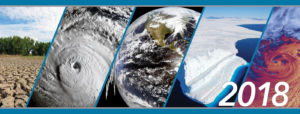End of year highlights 2018
Image credits: Bill Bellon, SSEC/CIMSS, NASA, NOAA
As the new director of the Space Science and Engineering Center, I look forward to working with our university, government and industry partners to conduct research to solve pressing environmental problems, just as my predecessors have done over more than five decades.
At SSEC, science stimulates innovation. Our basic and applied research programs have grown out of novel approaches to developing and utilizing observations to improve forecasts, understand Earth’s atmosphere and climate to benefit the people of Wisconsin and around the world.
Looking ahead to the scientific challenges and opportunities of 2019 and beyond, I invite you to reflect on our shared accomplishments of the last year. Each story below provides a window into our commitment to the advancement of science through collaborative research, education and public engagement.
Best wishes for a Happy New Year,
R. Bradley Pierce, SSEC Director
-
NOAA listening session: Plan to improve forecasting includes CIMSS
Dr. Neil Jacobs, assistant secretary of commerce for environmental observation and prediction at the National Oceanic and Atmospheric Administration (NOAA), visited Madison for a listening session on Nov. 26, 2018. He was gathering input and laying out a vision to improve U.S. weather forecasts to better meet the needs of society.
Published: December 19, 2018 -
A case for geo-sounders
Researchers at the UW-Madison CIMSS and NOAA have concluded that the inclusion of hyperspectral sounders on United States geostationary satellites could fill some global satellite data gaps and lead to significant improvements in predicting local severe weather.
Published: October 26, 2018 -
New SSEC Director Brad Pierce Shares his vision
Brad Pierce began serving as Director of SSEC at UW-Madison on Oct. 1, 2018. His background includes over 25 years as a scientist with the National Oceanic and Atmospheric Administration (NOAA) and NASA. We talked with him about his vision for SSEC, what he brings to the role and his ideas about how to meet current and future challenges and opportunities.
Published: October 3, 2018 -
Center of the storm
A hurricane’s eye – an area of relatively low pressure and wind – is one of its most distinctive features. It stands in stark contrast to the storm’s strongest winds found on the other side of the eyewall: the eye is a region of calm surrounded by raging wind.
While studies have examined different features of hurricane eyes, little research has been done to understand their frequency.
Published: September 04, 2018 -
Terry Kelly, visionary of computerized weather, elected Fellow of the American Meteorological Society
Terry Kelly, UW-Madison alumnus and entrepreneur, turned consulting and television weathercasting on its end through his revolutionary work in computerized weather. Last year, the American Meteorological Society honored Kelly with its highest distinction — Fellow of the AMS — for his leading role in charting a new course for real-time television weather broadcasting.
Published: July 09, 2018 -
MODIS + ASTER = CAMEL
UW-Madison CIMSS scientist Eva Borbas collaborated with colleagues at NASA's Jet Propulsion Laboratory to merge their individual databases of global land surface emissivity into the new, improved CAMEL product.
Published: July 02, 2018 -
Flash drought
Good science rests on the adoption of universally accepted definitions of terms. Scientists need confidence that when they use a term its meaning will be unambiguous.
Currently, a debate continues in the climate community about the definition of “flash drought” says Jason Otkin, a drought researcher at UW-Madison CIMSS.
Published: June 22, 2018 -
Modeling towards resilience and supporting Puerto Rico
As Hurricane Irma tracked closer to Puerto Rico on Sept. 6, 2017, Shane Hubbard watched closely from 2,100 miles away. Hubbard, a natural disaster and flood researcher at UW-Madison SSEC, had helped design flood mitigation strategies for San Juan neighborhoods on a visit just six months earlier.
Published: June 04, 2018 -
Ultralight science
Using an ultralight aircraft as a research platform, UW-Madison Atmospheric and Oceanic Sciences professor Grant Petty is leading a study to better understand the Earth’s atmosphere by studying the boundary layer.
Published: May 16, 2018 -
Margaret Mooney recognized for public service and outreach
Margaret Mooney, director of the Office of Education and Public Outreach at UW-Madison CIMSS, was selected to receive the university’s 2018 Robert and Carroll Heideman Award for Excellence in Public Service and Outreach. She was one of nine academic staff selected to receive excellence awards in spring 2018.
Published: April 10, 2018 -
Snowfall patterns, cloud types may provide clues to Greenland Ice Sheet
To better understand and anticipate changes in sea level rise, researchers led by UW-Madison SSEC scientist, Claire Pettersen, described a unique method involving cloud characteristics that could help answer some big questions about the Greenland Ice Sheet and its snowfall.
Published: April 09, 2018 -
UW takes science lead on NASA CubeSat mission to measure Arctic radiant energy
The Polar Radiant Energy in the Far Infrared Experiment (PREFIRE) led by UW-Madison principal investigator Tristan L’Ecuyer, will collect data in a rarely observed part of the energy spectrum, giving new insight into Arctic warming, sea ice loss, ice sheet melt and sea level rise.
Published: February 09, 2018 -
Shared data, shared discovery with JPSS-1
For decades, the world meteorological satellite community has operated under a policy of freely shared data – no restrictions and unencrypted – available at no cost. It is a philosophy and model of cooperation, first promoted by the United States and adopted by global satellite agencies, that endures regardless of political or national persuasion.
Published: February 02, 2018

